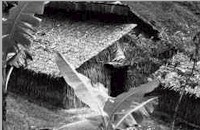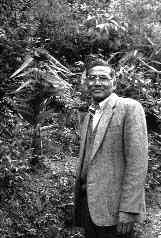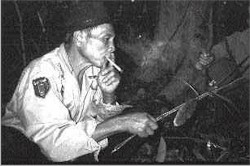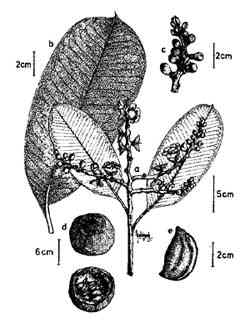Backgrounds
These plant
portraits come from the Projek Etnobotani
Kinabalu, further described below. Feel
free to send good quality slides of
seeds, leaves and textures that
illustrate a project in which you are
involved, or of local ethnobotanists with
whom you work. We will try to include
them in a future issue of the
Handbook. - GJM
|
 |
Textures,
from a basket (barait)
made by Dusun weavers
around Kinabalu Park. The
framework of the basket
shown in the background
of the Viewpoints section
is made from Calamus
ornatus (Arecaceae), a
robust rattan palm which
grows in primary
dipterocarp forests of
Malaysia, Indonesia,
Phillipines and Southern
Thailand. |
The baskets are
woven with the stems of a weedy
species of Lygodium, a climbing
fern common in lowland secondary
forests. Barait were originally
made from Calamus caesius
(Arecaceae), but the design and
materials are changing as a
response to increasing scarcity
of this rattan in areas where
there are high rates of
deforestation and intensive
harvesting of the cane.
Baskets
made from C. ornatus and Lygodium
require less labor than those
made from C. caesius, and are in
demand by tourists who visit the
region. Increased marketing of
these baskets is now leading to
scarcity of C. ornatus in some
weaving communities, and to
substitution with other rattan
species.
|
|
 |
| A
house for mushroom
cultivation in Kiau,
Malaysia made with Metroxylon
sagu thatch |
|
Leaves, from the
thatch of a house used
for cultivating mushrooms
in Kiau, a Dusun
community around Kinabalu
Park in Sabah, Malaysia.
The thatch is made from
the leaves of Metroxylon
sagu (Arecaceae) |
The palms around Kinabalu Park
have been a special focus of the
Projek Etnobotani Kinabalu, an
ethnobotanical program
coordinated by Sabah Parks, the
state conservation agency, in
collaboration with the Institute
of Biodiversity and Environmental
Conservation (IBEC) of the
Universiti Malaysia Sarawak
(UNIMAS), and the WWF-UNESCO-Kew
People and Plants Initiative,
with support from the John D. and
Catherine T. MacArthur
Foundation. In creating the PEK,
these partners proposed to
develop activities that
contribute to:
- ethnobotanical research,
focused on building a
team of local Dusun
people, park personnel
and visiting researchers
who study patterns of
Dusun classification,
management and use of
plants;
- conservation of pristine
areas, by developing the
ability of park personnel
to assess the ecological,
cultural and economic
importance of locally
used botanical resources
and by strengthening
links between the park
research staff and Dusun
communities;
- environmental education,
by providing research and
training opportunities
for students from
Malaysia and other Asian
countries and by
enriching interpretive
programs and exhibits for
the more than 200,000
people who visit the park
every year; and
- community development,
through improving the
management of unprotected
forests in buffer zones
around Kinabalu Park and
promoting the viability
of Dusun ecological
knowledge.
The project is now being
extended to Crocker Range Park,
also in Sabah. Contact: Datuk
Lamri Ali, Director, Sabah Parks,
P.O. Box 10626, 88806 Kota
Kinabalu, Sabah, Malaysia; Tel.
+60.88.221228, Fax +60.88.221001
|
|
 |
Seeds?
No, these are pellets of
sago, the starchy food
produced from the stem
pith of Metroxylon sagu
and other palms in
Southeast Asia and
Polynesia. The Italian
botanist Odoardo Beccari
described how it was made
during his visit to
Sarawak, Malaysia in
1865: |
‘The
operation of “tindjak,”
or washing, is performed by
placing the pith in the mat or
basket, and treading it steadily
with the bare feet while an
assistant pours water over it
from time to time. Even the pails
used for this purpose are
constructed from the sago palm.
They are conical in shape, and
are made from the thin laminar
and coriaceous portion of the
base of the fronds where they
encircle the stem.
This method of treading the
baskets with the feet causes the
stuff expressed to be carried off
by the water through the meshes
of the mat or basket, and to
collect in a vessel placed
beneath, which is usually a small
canoe. Here it settles down, and
after the water has been drained
off constitutes what the natives
call “lamanta.” After
it has been dried and reduced to
a granular form (pearling) it
becomes the sago we all
know.’
From:
Beccari, O. 1986[1904].
Wanderings in the Great Forests
of Borneo. Oxford University
Press, Singapore.
This book,
full of descriptions of the
natural history and cultures of
Malaysia, was reissued as part of
the series called Oxford in Asia
Hardback Reprints. Contact:
Oxford University Press Pte.
Ltd., Unit 221, Ubi Avenue 4,
Singapore 1440.
|
BACK
Profiles
 |
Narayan
P. Manandhar
Narayan P. Manandhar has carried
out research on plants used in
human and veterinary medicine in
various parts of Nepal, including
the Chitwan, Dhading, Gorkha,
Kabhrepalanchok and Myagdi
districts. A recent article on
medicinal herbs of Myagdi
district reflects his approach
and the changing landscape of his
native Nepal. He notes: ‘...
the use of herbal medicine has
declined rapidly along with the
depletion of forest.
|
The country has now
experienced rapid deforestation with the
total forest cover being lost at the rate
of 2.1% per year. The younger generation
is now attracted to urban places. Only
the older people have the knowledge of
local and rural medicine. It is of prime
importance to document the evidence of
herbal medicine that still exists, to
learn to maintain the equilibrium between
utilization and conservation of these
natural plant resources, and to involve
the local people in natural resource
management.’
From:
Manandhar, N.P. 1995. An inventory of
some herbal drugs of Myagdi District,
Nepal. Economic Botany 49(4):371-379.
Contact: N.P. Manandhar, Ethnobotanist,
National Herbarium and Plant
Laboratories, P.O. Box 3389, Kathmandu,
Nepal; Tel. +977.1.223888, Fax
+977.1.290549
 |
Andau
Pendiling
Andau Pendiling, some 60 years
old, is from Himbaan, Bundu
Tuhan, a community which borders
the southern part of Kinabalu
Park in Sabah, Malaysia. Many
people from Bundu Tuhan and other
Dusun communities work in the
Park as staff scientists,
naturalists and guides.
|
Along with
his brother, Intang Pendiling, Andau has
participated in the Projek Etnobotani
Kinabalu, described on the preceding
page. Their detailed knowledge of
the local names and uses of palms and
other plants has been recorded by younger
members of their village. One of
Andau’s sons, Daim Andau, is
collecting plants and recording their
uses and names in another community,
Nalumad, on the eastern border of the
Park. These results will be included in a
guidebook produced by the Park, which
will include line drawings and
ethnobotanical information on selected
useful plants. To be published in Bahasa
Malaysia, the guidebook will be
distributed in local communities and the
Park.
In the picture on
the front cover of the Handbook, Andau is
shown collecting damar resin, formerly an
important non-timber forest product in
Borneo, used as an ingredient in
varnishes and as lamp fuel. Around
Kinabalu Park, it is used as a fuel and
fire starter.
BACK
 |
What
is this ... ?
It is
Bertholletia excelsa Humb. &
Bonpl. (Lecythidaceae), commonly
called Brazil nut or Pará nut in
English, and nuez de Brasil or
castaña in Spanish. Native to
the Amazon, it is an important
source of income for local people
in several Latin American
countries. The edible brazil nut
of commerce is the oily endosperm
of the seed, which is covered
with a woody testa. Many seeds
are found inside the large woody
fruit, which matures over a
period of 14 months. Most brazil
nuts are collected from wild
trees.
|
The
illustration is from Killeen, T.J., E.
García E. and S.G. Beck. 1993. Guía de
Árboles de Bolivia. Quipus, La Paz. This
guide to the trees of Bolivia includes
more than 100 families, 650 genera and
2700 species of woody plants. Apart from
taxonomic and phytogeographic
information, it contains data on the
local names and uses of many species. It
is available in Latin America from
Editorial del Instituto de Ecología,
Universidad Mayor de San Andrés, Casilla
10077 - Correo Central, La Paz, Bolivia;
Fax +591.2.797511 or in the United States
from the Department of Publications,
Missouri Botanical Garden, P.O. Box 299,
St. Louis, MO 63166-0299, USA.
BACK
|